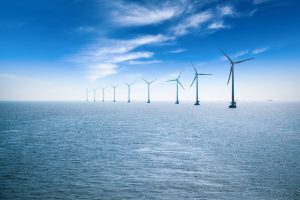On July 16, Italian renewable energy developer Renexia announced that it was in advanced talks with Mingyang, a Chinese wind turbine manufacturer, to supply an upcoming 2.8 GW floating wind farm. The project, called “Med Wind,” is located off the coast of Sicily and will employ up to 190 16.6 MW floating wind turbines.
This represents a big step for Mingyang, the publicly traded wind turbine original equipment manufacturer (OEM) based in Guangdong. In 2023, Mingyang manufactured 9 GW of wind turbines, putting it in fifth place globally according to BloombergNEF. The Bloomberg NEF analysis indicated that in all of 2023, China-based wind turbine OEMs collectively commissioned 1.7 GW of wind projects overseas. If completed, the Med Wind project alone will top that 2023 total by 64 percent.
Mingyang’s push into the Italian market comes as a part of a larger effort from Chinese OEMs to expand into Europe. In 2022, Mingyang supplied turbines for a 30 MW offshore project in Italy – the first European offshore wind farm powered by turbines from a Chinese manufacturer. More recently, on July 2, 2024, Mingyang announced that it had entered an agreement to supply 16 large 18.5 MW offshore turbines to Luxcara, a German renewable energy developer. The turbines will be installed in the German North Sea as a part of “Waterkant,” a 300 MW offshore wind farm.
Chinese wind turbines have gained a foothold in Europe and other international markets because they are cheap. Analysis from Trivium China indicated that Chinese turbine OEMs can produce turbines for as little as one-fourth the cost of their European counterparts. The result is that in 2023, four of the five largest wind turbine OEMs were Chinese. Between 2018 and 2022, EU companies’ share in the global wind turbine market fell from 55 percent to 42 percent, with China capturing virtually all of that market share. 2023 was another hard year for Western OEMs, with companies across Europe and the U.S. suffering financial losses.
In response to these trends, in April of 2023, the European Commission announced an inquiry into illegal subsidies for Chinese wind turbine OEMs. Coming on the back of the EU anti-subsidy probe into Chinese made EVs, it seems like European policymakers are trying to get out ahead of the potential incoming wave of cheap, high-quality Chinese wind turbines.
Though Chinese OEMs already control more than 60 percent of the global wind turbine manufacturing market, that is less of a stranglehold than the over 90 percent control that Chinese firms enjoy in segments of the photovoltaic supply chain. Implementing tariffs now, while there are still powerful European OEMs in the market left to protect, might preserve domestic market share for European firms.
The results of the inquiry have not been released, but the anti-subsidy probe and other investigations by the European Commission into Chinese state support for private industry give hints of what might be to come. In an April 2024 report titled “Commission Staff Working Document on Significant Distortions in the Economy of the People’s Republic Of China for the Purposes of Trade Defense Investigations,” the authors concluded that previous research has “established the presence of significant distortions in the [wind turbine manufacturing] sector.” That indicates that the new inquiry into Chinese-made wind turbines is likely to draw a similar conclusion.
Even if the European Commission concludes that tariffs are necessary, it isn’t clear how they will be structured. In the case of EVs, the European Commission has established a sliding scale of tariffs ranging from 17.4 percent to 37.6 percent, on top of a preexisting 10 percent duty that was already in place for all electric cars imported from China. According to the New York Times, the tariff levels were calculated based on the extent to which Chinese automakers complied with the probe.
This indicates that the same staggered tariff structure might be used if the EU decides to impose a tariff on Chinese wind turbines. Because Mingyang is one of the few privately owned major Chinese wind turbine OEMs, they might have more latitude to work with the EU to face a lower tariff level.
These economic considerations are further complicated by Europe’s ambitious climate goals. The EU needs to decarbonize its power sector, and fast. The bloc achieved its 2020 goal of increasing the share of renewable energy use to 20 percent, but faces an uphill battle to reach the more ambitious goal of 42.5 percent renewable energy use by 2030.
Amid this uncertainty, one thing is for sure: placing tariffs on Chinese wind turbines will make Europe’s energy transition more expensive. Given all of this context, it seems that European policymakers and renewable energy developers might be trying to take advantage of this window of opportunity before any tariffs are levied to build out their capacity with cheap Chinese turbines.

































